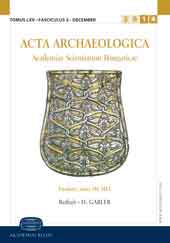FROM FARMERS TO WARRIORS AND CONQUERORS A COMPARISON OF LONGOBARD ETHNOGENETIC DEVELOPMENT AND ARCHAEOLOGICAL DATA
FROM FARMERS TO WARRIORS AND CONQUERORS A COMPARISON OF LONGOBARD ETHNOGENETIC DEVELOPMENT AND ARCHAEOLOGICAL DATA
Author(s): Paolo De VingoSubject(s): Archaeology, Cultural history, Social history, 6th to 12th Centuries, Migration Studies, Ethnic Minorities Studies
Published by: Akadémiai Kiadó
Keywords: Longobards; ethnic groups; religion; origin; law; migration;
Summary/Abstract: The most reliable accounts of the oldest part of Longobard history are provided by authors from both the classic (Strabo, Tacitus, Velleius Paterculus) and the Byzantine school of thought (Iordanes, Procopius of Caesariensis) even if a detailed analysis of such works reveals an extensive time gap between the early stages of the imperial period and the end of the 5th century. The Historia Langobardorum, written only in the second half of the 8th century by Paul the Deacon, provides the most important written evidence. Its complex narration, which is based however on a unified and ordered sequential logic, explains the origins behind the process of formation and detachment that differentiated the Longobard population from the other Germanic demographic units with which it shared a common history in the continental European areas for at least five centuries. Its author points out that most of the Germanic peoples (Vandals, Rugians, Heruls, Thuringians and Goths) shared a common homeland represented by the Scandinavian region from where they began a long period of migration toward the southern European areas. A summary of the oldest events is contained in the Origo Gentis Langobardorum, the preamble of the text recognised as Rotari’s Edict, although it was never attributed to any official author. A continuation of the Origo Gentis Langobardorum, known as Historia Langobardorum Codicis Gothani, further chronicles the history of the Longobard population up to the 8th century. In light of such considerations, the extended period of time between the presumed Scandinavian origins and this population’s appearance in northern Germany – during which the early medieval sources describe the very important changes in the social and cultural structure – is of fundamental importance in understanding how the subsequent events unfolded. As a result, the opportunity of studying the beginnings of Longobard history, and thus of analysing the formation of the process of ethnogenesis during its initial phases, can help identify the original socio-economic characteristics of this population, what social transformations took place and the reasons that affected or led to such changes.
Journal: Acta Archaeologica Academiae Scientiarum Hungaricae
- Issue Year: 59/2008
- Issue No: 2
- Page Range: 277-311
- Page Count: 35
- Language: English
- Content File-PDF

